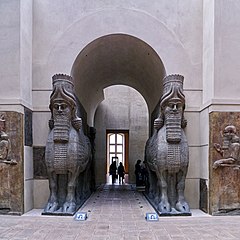Lamassu


A lamassu (Cuneiform: 𒀭𒆗, AN.KAL; Sumerian: dlamma; Akkadian: lamassu) is an Assyrian protective deity, often depicted with a bull or lion's body, eagle's wings, and human's head.[1] In some writings, it is portrayed to represent a female deity.[2][3] A less frequently used name is shedu (Cuneiform: 𒀭𒆘, AN.KAL×BAD; Sumerian: dalad; Akkadian, šēdu; Hebrew: שד) which refers to the male counterpart of a lamassu.[4] See the etymology section for a full explanation of the relationship of the names.
Iconography

In art, lamassu were depicted as hybrids, winged bulls or lions with the head of a human male. There are still surviving figures of lamassu in bas-relief and some statues in museums, most notably in the British Museum in London, Musée du Louvre in Paris, National Museum of Iraq in Baghdad, Metropolitan Museum of Art in New York, Pergamon Museum in Berlin and the Oriental Institute, Chicago. They are generally attributed to the ancient Assyrians. The lamassu is at the opening of the city, so that everyone who enters sees it. From the front it appears to be standing and from the side walking. This was intentionally done to make it seem powerful. The lamassu in real life is very tall. In this case the lamassu is being used as a symbol of power.[5][6] The motif of a winged animal with a human head is common to the Near East, first recorded in Ebla, around 3000 BCE. The first distinct lamassu motif appeared in Assyria during the reign of Tiglath-Pileser [disambiguation needed]. A winged bull with the head of a bearded man appears on the logo of United States Forces - Iraq in reference to Iraq's ancient past.
Terminology
This article may be confusing or unclear to readers. |


Although "lamassu" had a different iconography and portrayal in Sumerian culture, the terms lamassu, alad, and shedu were used to denote the Assyrian-winged-man-bull symbol and statues during the Neo-Assyrian empire. Female lamassus were called "apsasû".[1] The motif of the Assyrian-winged-man-bull called Aladlammu and Lamassu interchangeably is not the lamassu or alad of Sumerian origin which were depicted with different iconography.[clarification needed] These monumental statues were called aladlammû or lamassu which meant "protective spirit".[1][clarification needed] In Hittite the Sumerian form dLAMMA is used both a name for the so-called "Tutelary deity" identified in certain later texts with Inara and a title given to various other tutelary or similar protective gods.[7]
Mythology
The lamassu is a celestial being from Mesopotamian mythology. Human above the waist and a bull below the waist, it also has the horns and the ears of a bull. It appears frequently in Mesopotamian art, sometimes with wings. The lamassu and shedu were household protective spirits of the common Babylonian people, becoming associated later as royal protectors, were placed as sentinels at the entrances. [citation needed] The Akkadians associated the god Papsukkal with lamassu and the god Išum with shedu.
To protect houses, the lamassu were engraved in clay tablets, which were then buried under the door's threshold. They were often placed as a pair at the entrance of palaces. At the entrance of cities, they were sculpted in colossal size, and placed as a pair, one at each side of the door of the city, that generally had doors in the surrounding wall, each one looking towards one of the cardinal points.
The ancient Jewish people were influenced by the iconography of Assyrian culture. The prophet Ezekial wrote about a fantastic being made up of aspects of a human being, a lion, an eagle and a bull. Later, in the early Christian period, the four Gospels were ascribed to each of these components. When it was depicted in art, this image was called the TETRAMORPH. Since the Lammasu was seen and experienced as a symbol of awesome power by the Jews, the logical inference is that Jesus Christ was now understood as the penultimate power in the world.
In fiction
Lammasu [sic] and shedu are two distinct types of good-aligned creatures in the role-playing game Dungeons & Dragons. Lammasu also appear in the Magic: The Gathering trading card game as the white card Hunted Lammasu[8] in the Ravnica: City of Guilds expansion.
A bull with a man's head is found among the creatures that make up Aslan's army in The Lion, the Witch and the Wardrobe. He appears at the Stone Table, challenging the White Witch "with a great bellowing voice". In the film Alexander, Lamassu are seen at the Ishtar Gate in Babylon. In the Disney movie Aladdin, a gold Lamassu can be found in the scene where Aladdin and Abu enter the cave in the desert to find the lamp.
In the Games Workshop miniatures wargame, Warhammer Fantasy Battle, the Lamasu was a mount for the Chaos Dwarf army. It has since returned as part of the Storm of Magic expansion release. A Lammasu briefly appears in the Fablehaven series.
See also
| External videos | |
|---|---|
References
- ^ a b c Livius.org
- ^ Beaulieu, Paul-Alain. The Pantheon of Uruk during the Neo-Babylonian Period. Retrieved 9 December 2010.
- ^ "The Pennsylvania Sumerian Dictionary". Retrieved 9 December 2010.
- ^ Black, Jeremy; Green, Anthony (2003). An Illustrated dictionary, Gods, Demons and Symbols of Ancient Mesopotamia. The British Museum Press. ISBN 0-7141-1705-6.
- ^ "History - Mesopotamia". BBC.
- ^ "Lamassu". ancientneaeast.net.
- ^ Gregory McMahon, The Hittite State Cult of the Tutelary Deites. Oriental Institute Assyriological Studies, no. 25
- ^ "Hunted Lammasu".
- ^ "Assyrian Human Headed Winged Lion and Bull (Lamassu)". Smarthistory at Khan Academy. Retrieved January 8, 2013.
